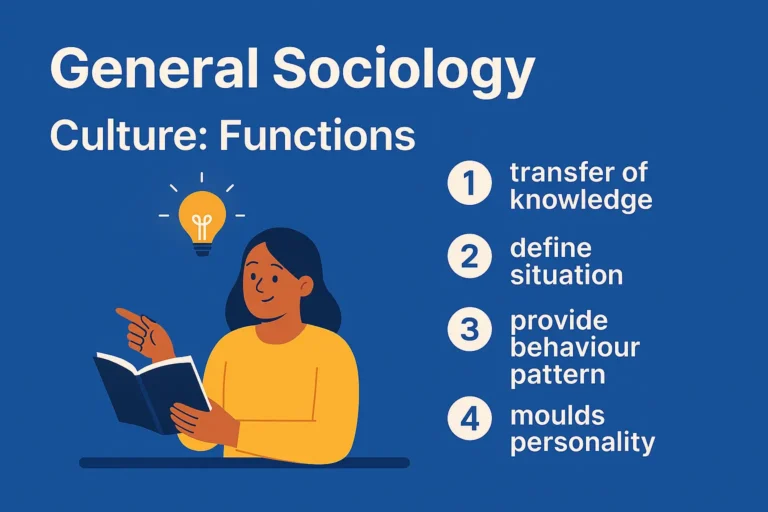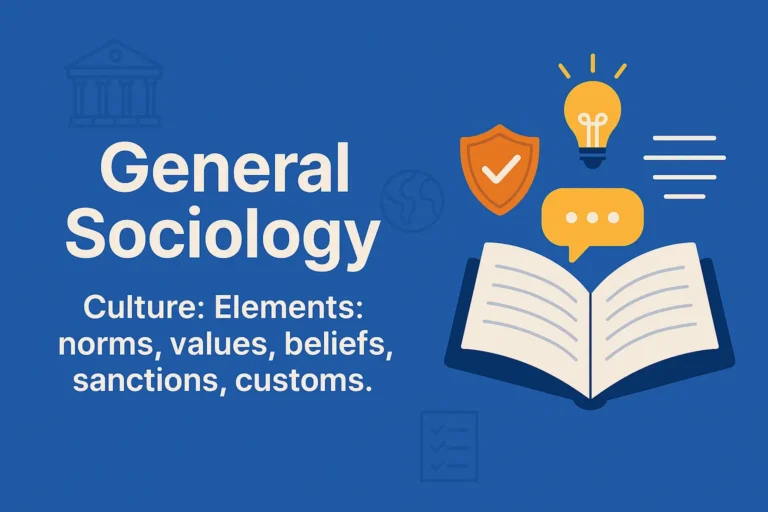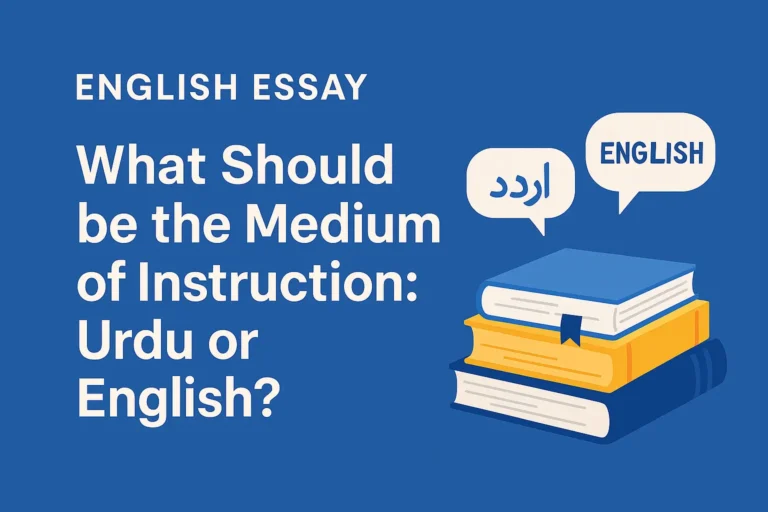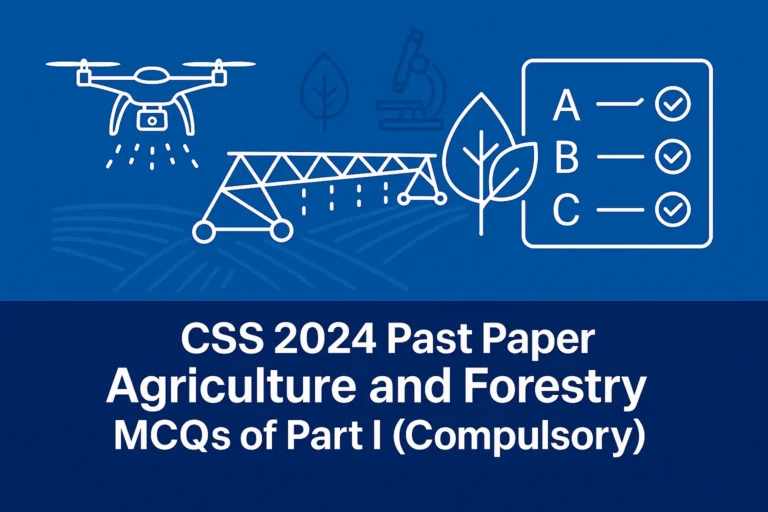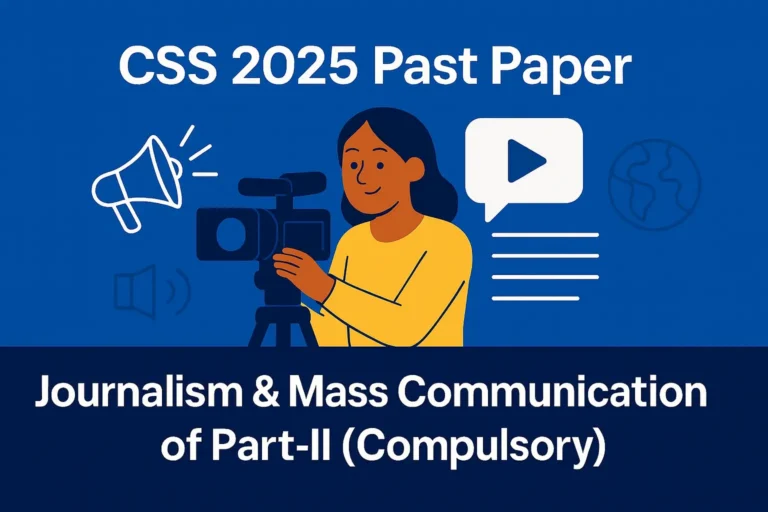CSS 2023 Special Exam Solved Past Paper – Journalism & Mass Communication MCQs of Part-I (Compulsory)
Below are the solved multiple-choice questions (MCQs) of Part-I from the CSS 2023 Special Exam Journalism & Mass Communication paper. Each question includes all the options, the correct answer is bolded, and a short explanation is provided for clarity.
1. George Gerbner developed his model of communication in:
(A) 1954
(B) 1955
(C) 1956
(D) None of these
💡 Gerbner’s General Model of Communication was introduced in 1956.
2. Masthead refers to:
(A) Place of printing of a newspaper
(B) Ownership of a newspaper
(C) Circulation of a newspaper
(D) None of these
💡 Masthead shows ownership, editorial, and publishing details of a newspaper.
3. TRP stands for:
(A) Television Research Programme
(B) Television Rotation Plan
(C) Television Rating Point
(D) None of these
💡 TRP measures viewership of television programs.
4. Lasswell’s communication model describes:
(A) Verbal communication
(B) Visual communication
(C) Written communication
(D) None of these
💡 Lasswell’s model asks “Who says what, in which channel, to whom, with what effect?”—focused on verbal process.
5. Podcast means:
(A) A digital pdf format program downloadable on the Internet
(B) A digital video format program downloadable on the Internet
(C) A digital animated format program downloadable on the Internet
(D) None of these
💡 Podcast is an audio program available for streaming or download online.
6. Diffusion of innovations is a theory:
(A) That seeks to explain how, why, and at what rate new ideas and technology spread
(B) That seeks to produce machines for ideas and technology
(C) That laws, why, and at what rate new ideas and technology spread
(D) None of these
💡 Everett Rogers’ theory explains adoption of innovations in society.
7. The theory of “The medium is the message” was developed by:
(A) Paul Lazarsfeld
(B) Denis McQuail
(C) Marshall McLuhan
(D) None of these
💡 McLuhan argued the medium itself shapes meaning more than content.
8. The term New World Information and Communication Order (NWICO) was coined in UNESCO in the late:
(A) 1940s
(B) 1950s
(C) 1960s
(D) None of these
💡 NWICO debates began in UNESCO during the late 1960s.
9. NWICO aimed to address the imbalance in communication flow from the:
(A) West to the rest of the world
(B) West to the Arab world
(C) West to the modern world
(D) None of these
💡 NWICO criticized one-way flow of information from Western to developing nations.
10. Media violence poses a _________ to public health as much as it leads to an increase in real-world violence and aggression.
(A) Happiness
(B) Safety
(C) Threat
(D) None of these
💡 Media violence is recognized as a threat to public health.
11. Media democracy is a democratic approach to media studies that advocates reform of mass media to strengthen:
(A) Community service broadcasting
(B) Commercial service broadcasting
(C) Public service broadcasting
(D) None of these
💡 Media democracy emphasizes public service broadcasting and accountability.
12. In media studies, representation is the way where aspects of society (gender, age, ethnicity) are presented to:
(A) Campaigners
(B) Audiences
(C) Dissenters
(D) None of these
💡 Representation in media constructs images for audiences.
13. In _______________ there is a problem of the public not always knowing where their money is going or what company they may be endorsing.
(A) Media Democracy
(B) Media Conglomeration
(C) Media Hegemony
(D) None of these
💡 Media conglomeration hides ownership, leading to consumer unawareness.
14. The first Editor of the English Daily The Frontier Post was:
(A) Shoukat Siddiqui
(B) Aziz Siddiqui
(C) Naveed Siddiqui
(D) None of these
💡 Aziz Siddiqui was the founding editor of The Frontier Post.
15. Commercialism of media is the application of news production and consumption towards:
(A) Social usage
(B) Economic usage
(C) Personal usage
(D) None of these
💡 Commercialism treats media as an economic commodity.
16. Traditionally, popular culture was associated with poor education and lower classes, as opposed to the ________________ and higher education of upper classes.
(A) Western culture
(B) American culture
(C) Official culture
(D) None of these
💡 Official culture was linked with elites and higher education.
17. Who was the first Information Minister of Pakistan?
(A) Fazlur Rahman
(B) Ghulam Muhammad
(C) Raja Ghazanfar Ali
(D) None of these
💡 Raja Ghazanfar Ali was Pakistan’s first Information Minister.
18. ________________ is considered a pioneer in public relations and propaganda, referred to as “the father of public relations”:
(A) Edward James Olmos
(B) Edward Louis Bernays
(C) Edward John Norton
(D) None of these
💡 Edward Bernays, Freud’s nephew, pioneered PR and propaganda theory.
19. The Press and Publications Ordinance (PPO) of 1960 allowed appeals against security deposits in a Special Bench of the:
(A) High Court
(B) Civil Court
(C) Session Court
(D) None of these
💡 Appeals under PPO 1960 went to a special bench of the High Court.
20. Under the RPPO, if any organisation fails to start printing/publication within _______ months of its declaration, it is cancelled.
(A) Four
(B) Five
(C) Six
(D) None of these
💡 Failure to publish within six months leads to cancellation under RPPO.

